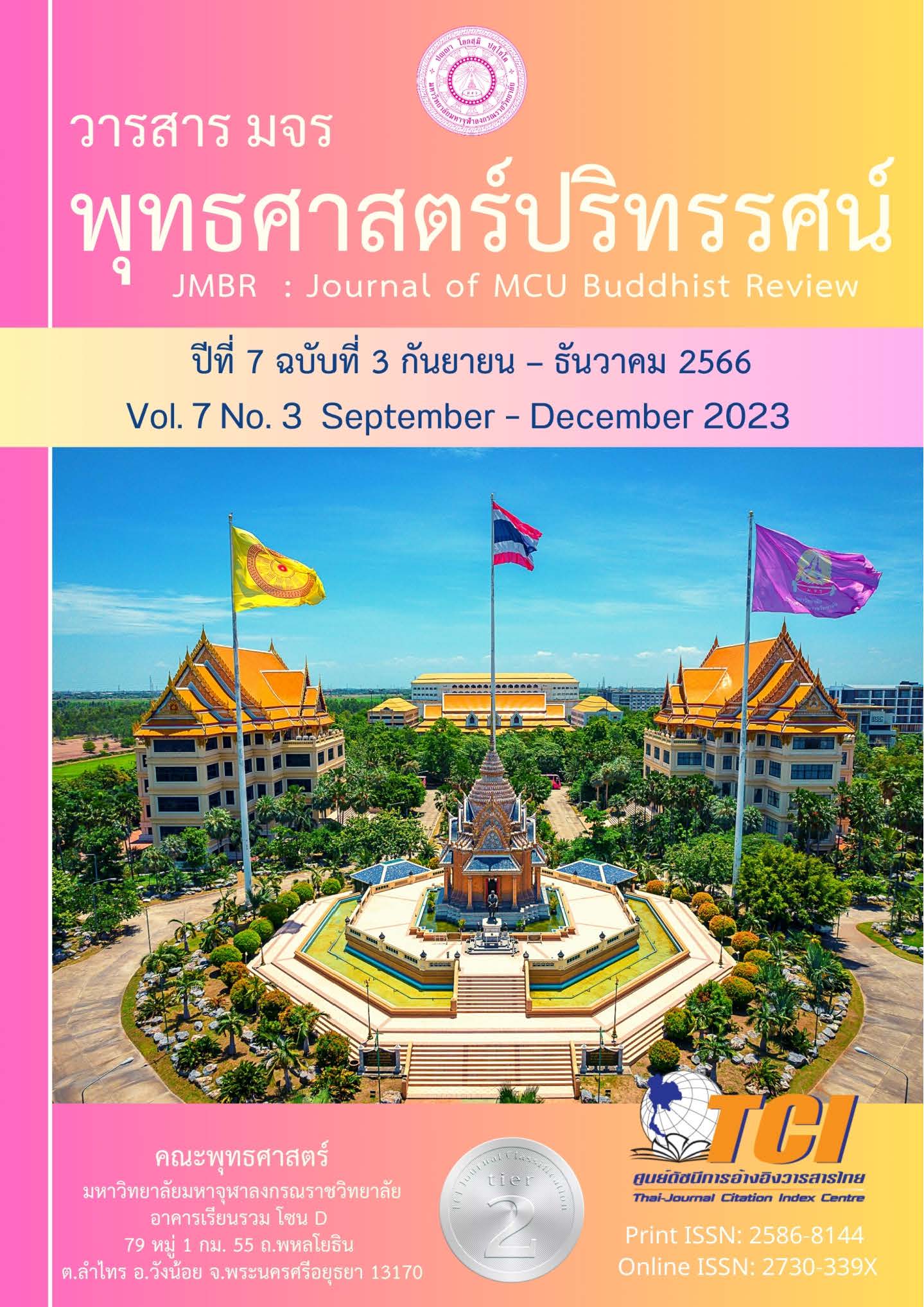การรู้เท่าทันผัสสายตนะในวิถีแห่งปฏิจจสมุปบาท
Main Article Content
บทคัดย่อ
ผัสสายตนะ คือ การเกิดผัสสะระหว่าง อายตนะภายใน 6 และ อายตนะภายนอก 6 กระทบกัน เกิดการรับรู้ (วิญญาณ) ในลักษณะที่เป็นลูกโซ่ตลอดสาย ทั้งสายเกิดและสายดับ ในวิถีทางแห่งชีวิตตั้งแต่เกิดจนตาย และส่งผลไปถึงภพหน้า เป็นวิถีแห่งปฏิจจสมุปบาทที่เป็นกระบวนการอาศัยกันเกิดของ ตัณหา อุปาทาน ถ้าหากว่ามนุษย์รับผัสสะไม่ถูกต้อง จะนำไปสู่เวทนา แล้วนำไปสู่ตัณหา อุปาทาน ทำให้มีการเกิด ภพ ชาติ วนเวียนอยู่ไม่รู้จักจบสิ้น เป็นเหตุแห่งทุกข์ ดังนั้น เมื่อเกิดผัสสะ เช่น เมื่อตาเห็นรูป บุคคลควรจะรู้เท่าทันให้หยุดอยู่ที่การเห็น ไม่มีความรู้สึกว่า ชอบ หรือไม่ชอบ ตามมา สามารถหยุดอยู่เพียงการกระทบกันของอายตนะ สิ่งนี้ คือ การรู้เท่าทันผัสสายตนะ เป็นการรู้เท่าทันปัจจุบัน การเห็นความจริงตามที่สิ่งนั้นเป็น
Article Details

อนุญาตภายใต้เงื่อนไข Creative Commons Attribution-NonCommercial-NoDerivatives 4.0 International License.
- บทความที่ได้รับการตีพิมพ์เป็นลิขสิทธิ์ของวารสาร มจร พุทธศาสตร์ปริทรรศน์
- ข้อความใดๆ ที่ปรากฎในบทความที่ได้รับการตีพิมพ์ในวารสาร ถือเป็นความรับผิดชอบของผู้เขียนบทความ และข้อคิดเห็นนั้นไม่ถือว่าเป็นทัศนะและความรับผิดชอบของกองบรรณาธิการวารสาร มจร พุทธศาสตร์ปริทรรศน์
เอกสารอ้างอิง
บรรจบ บรรณรุจิ. (2561). ปฏิจจสมุปบาท: ขั้นตอนการรู้แจ้งความจริงของพระพุทธเจ้าและการปรับใช้เพื่อแก้ปัญหาสังคม. มหาวิทยาลัยมหาจุฬาลงกรณราชวิทยาลัย. วารสาร มจร บาฬีศึกษาพุทธโฆสปริทรรศน์. 4(1), 1-26.
พระธรรมกิตติวงศ์ (ทองดี สุรเตโช. (2550). พจนานุกรมเพื่อการศึกษาพุทธศาสตร์ชุดศัพท์วิเคราะห์, กรุงเทพฯ: โรงพิมพ์เลี่ยงเชียง.
พระธรรมโกศาจารย์ (พุทธทาสภิกขุ). อายตนิกธรรม (ธรรมที่เนื่องอยู่กับอายตนะ). สืบค้น 7 สิงหาคม 2566 จาก: https://www.pagoda.or.th/buddhadasa/2525-5.html.
พระวรศักดิ์ วรธมฺโม. (2566). คุณ-ค่า พุทธศาสนา. กรุงเทพฯ: ธรรมสภา.
พุทธทาสภิกขุ. (2549). ปฏิจจสมุปบาทจากพระโอษฐ์. กรุงเทพฯ: สุขภาพใจ.
พุทธทาสภิกขุ. (ม.ป.ป). ผัสสะ คือ สิ่งที่ต้องรู้จักและควบคุม. กรุงเทพฯ: ธรรมทานมูลนิธิ.
มหาวิทยาลัยมหาจุฬาลงกรณราชวิทยาลัย. (2539). พระไตรปิฎกภาษาไทย ฉบับมหาจุฬาลงกรณราชวิทยาลัย. กรุงเทพฯ: โรงพิมพ์มหาจุฬาลงกรณราชวิทยาลัย.
แม่ชีวรรนรักษ์ ธนธรรมทิศ. (2561). “ศึกษาปฏิจจสมุปบาทฝ่ายเหตุในการปฏิบัติวิปัสสนาภาวนา”. ปริญญาพุทธศาสตรมหาบัณฑิต บัณฑิตวิทยาลัย: มหาวิทยาลัยมหาจุฬาลงกรณราชวิทยาลัย.
สมเด็จพระพุทธโฆษาจารย์ (ป.อ.ปยุตฺโต). (2564). พุทธธรรมฉบับปรับขยาย. พิมพ์ครั้งที่ 57. พระเมธี วชิโรดม พิมพ์เป็นธรรมทาน (Printed in China).
สมเด็จพระพุทธโฆษาจารย์ (ป.อ.ปยุตฺโต). (2566). หลักแม่บทของการพัฒนาตน. มงคลวาร อายุ 44 ปี ผศ.ดร.วัชรพจน์ ทรัพย์สงวนบุญ. ม.ป.ท.: ม.ป.พ.
อาจอง ชุมสาย ณ อยุธยา. (2549). “Mind-Set”. วารสารท่องโลกการศึกษา. 1(1), 32.
อำพล บุดดาสาร. (2563). “สัมมาทิฏฐิ: มัชฌิมศึกษาเพื่อพัฒนามนุษย์ที่สมบูรณ์”. วารสาร มจร บาฬีศึกษาพุทธโฆสปริทรรศน์. 6(1), 35.


